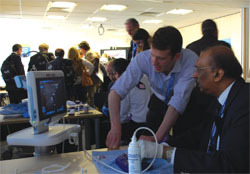For the fourth year running, the Charing Cross Office Based Veins Course offered a vast selection of the latest therapies to treat varicose veins in an office environment. Over two sessions, 300 participants were trained on steam thermotherapy, mechano-chemo ablation, foam sclerotherapy, thread vein treatment and endovenous ablation, among other techniques.
Although the course is becoming larger it has retained its key features of small groups and one-on-one teaching with a strong emphasis on hands-on practice. CX Daily News asked Ian Franklin course director (London, UK) about the nature of the course and its evolution. “We started this course four years ago and at that time, this was the first veins course specifically aimed at looking at office-based techniques. We try to include many techniques as we possibly can and do not try to tell people what is the right or wrong way of doing things. We just offer them all the techniques and they come along and make up their own minds based on what suits their practice best,” he said.
This year, the course has moved to more spacious surroundings. This is the “largest practical office-based vein practice course in the world,” said Franklin. “We have more space, so people are not pressured for time when learning their skills. We also have a number of new techniques that we did not have before, so people can have the updates on the latest techniques available.” Another addition to this year’s course was the incorporation of mini symposia on essentials of setting up a successful private vein practice and also case-based discussions demonstrating the effectiveness of office-based techniques, Franklin added.
Sherf Sholkamy, a surgeon from Cairo, Egypt, attended the course for the second year and has noticed how the course has helped him to evolve in treating thread and flare veins. “From this course, you get really good experience on how to do it and you just go home and do it,” he said. “I came a year ago to learn on the treatment of thread and flare veins and came back this year to resolve further questions, after practicing what I have learnt,” he added.
As well as attendees, physicians teaching the techniques have seen the course has evolved. Ravi Singh Ranger, who was teaching venous closure for the treatment of varicose veins commented, “When I first started doing this course three years ago, these were new techniques and doctors were more interested in whether they worked or not, and if they worked how they got about doing them. What I find today is that the whole pendulum has shifted and doctors are now not questioning the validity of the techniques. They have done this before and all they want to know is what I would do if I had a really big vein, or how I manage a tortuous vein. They want to learn how to treat it perfectly.”
Lowell Kabnick, New York, USA, said, “Each year, the course seems to expand the amount of materials that are covered. The physicians that are passing through have more interest, more and more knowledge and so this faculty has been able to accommodate this. The hands-on models are also getting better, they are more sophisticated.This is my third year participating on this course and every year it gets much better…this is the best hands-on course and I have been to many of them.” He told CX Daily News, this is a place where physicians can come to learn about venous disease and they get it all, both from a didactic perspective and a hands-on one.”








